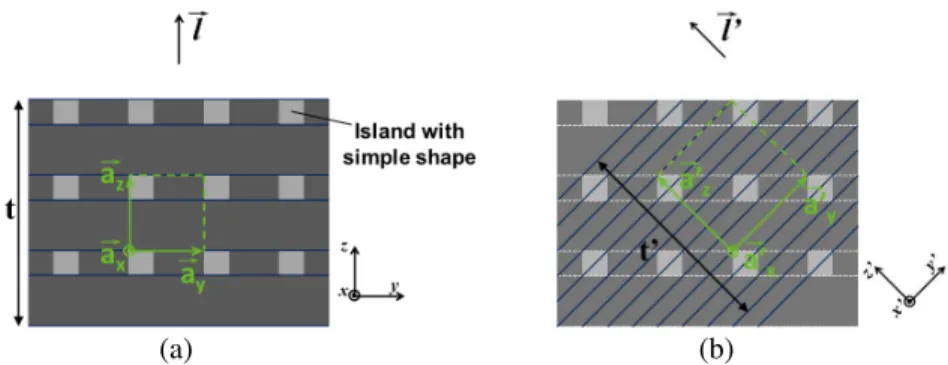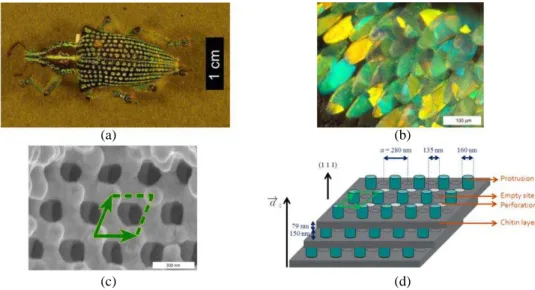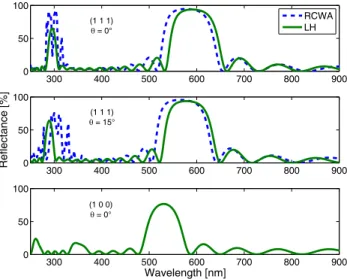RESEARCH OUTPUTS / RÉSULTATS DE RECHERCHE
Author(s) - Auteur(s) :
Publication date - Date de publication :
Permanent link - Permalien :
Rights / License - Licence de droit d’auteur :
Bibliothèque Universitaire Moretus Plantin
Dépôt Institutionnel - Portail de la Recherche
researchportal.unamur.be
University of Namur
Layer Homogenization Method for Modeling Additive Color Effect in Natural Photonic
Polycrystals --- The Case of Entimus imperialis Weevil
Mouchet, Sébastien; Vigneron, Jean-Pol; Colomer, Jean-François; Deparis, Olivier
Published in:Progress in Electromagnetics Research Symposium
Publication date: 2013
Document Version
Publisher's PDF, also known as Version of record
Link to publication
Citation for pulished version (HARVARD):
Mouchet, S, Vigneron, J-P, Colomer, J-F & Deparis, O 2013, Layer Homogenization Method for Modeling Additive Color Effect in Natural Photonic Polycrystals --- The Case of Entimus imperialis Weevil. in Progress in Electromagnetics Research Symposium. vol. Stockholm 2013, pp. 43-47, 34th Progress In Electromagnetics Research Symposium (PIERS), Stockholm, Sweden, 12/08/13.
<http://piers.org/piersproceedings/download.php?file=cGllcnMyMDEzU3RvY2tob2xtfDFBN18wMDQzLnBkZnwx MzAzMjcwNTMyMTg=>
General rights
Copyright and moral rights for the publications made accessible in the public portal are retained by the authors and/or other copyright owners and it is a condition of accessing publications that users recognise and abide by the legal requirements associated with these rights. • Users may download and print one copy of any publication from the public portal for the purpose of private study or research. • You may not further distribute the material or use it for any profit-making activity or commercial gain
• You may freely distribute the URL identifying the publication in the public portal ?
Take down policy
If you believe that this document breaches copyright please contact us providing details, and we will remove access to the work immediately and investigate your claim.
Layer Homogenization Method for Modeling Additive Color Effect
in Natural Photonic Polycrystals — The Case of Entimus
imperialis Weevil
S´ebastien Mouchet, Jean-Pol Vigneron, Jean-Fran¸cois Colomer, and Olivier Deparis Department of Physics, University of Namur, 61 rue de Bruxelles, B-5000 Namur, Belgium
Abstract— An original method for computing the reflectance of photonic crystal whose unit cell is composed of form-birefringence anisotropic elements (e.g., cylindres) is proposed. This method, based on the layer homogenization of the photonic crystal, is particularly useful when the reflectance is calculated for different crystal orientations. The far-field color due to an additive color effect in a natural photonic polycrystal found on Entimus imperialis weevil was investigated. 1. INTRODUCTION
Modeling the optical properties of photonic polycrystals is crucial for the investigation of natural photonic structures as well as for the design and fabrication of bioinspired devices [1, 2]. The computation of reflectance (or transmittance) of photonic crystals (PCs) by the Rigorous Coupled Wave Analysis (RCWA) method [1, 3] is sometimes cumbersome to perform due to the presence of form-birefringence anisotropic elements in the crystal unit cell (e.g., cylinders or parallelepipeds), particularly when it has to be calculated for various crystal orientations. The Layer Homogenization (LH) method proposed here solves this issue specifically for crystals with periodicities such that there is only specular reflection and no other diffraction orders [4]. For a single crystal orientation, the dielectric function is homogenized within the layers in which the crystal is sliced. A standard thin film solver is then used for the calculation of the reflectance. The disorder in the crystal orientations of the photonic polycrystal is taken into account by averaging reflectance spectra computed for various crystal orientations and incidence angles.
We demonstrate the usefulness of this method by applying it to the study of a natural photonic polycrystal. Polycrystals found in living organisms are known to give rise to multiscale visual effects such as additive colors. A nice example is found in cavities on the cuticle of Entimus imperialis [2, 4– 8]. This photonic polycristal is made of one single PC structure with different orientations [5], which is relevant for developing bioinspired applications. For instance, the E. imperialis structure has been recently replicated in order to serve as biomimetic devices such as gas, temperature or pH sensors [9].
2. PHOTONIC CRYSTAL WITH FORM ISOTROPIC AND ANISOTROPIC ELEMENTS
One of the most common method used to calculate the reflectance spectrum of 3D PC films is the RCWA method [1, 3] which is based on Fourier expansions of the dielectric function and of the electric and magnetic fields. In this method, a PC film is treated as a stratified medium with lateral periodicities. The layers of the PC film are perpendicular to the crystal orientation ~l and taken homogeneous along that orientation. Elements in the crystal unit cell (defined by translation vectors ~ax, ~ay and ~az) are therefore discretized into sets of non overlapping islands of different
materials, embedded in a host and having simple shapes such as cylinders or parallelipipeds with axes parallel to ~l. For instance, a spherical element is approximated by a set of cylinders (Fig. 1). Calculation of the reflectance according to different crystal orientations is easily performed due to the form isotropy of the sphere: the discretization is the same whatever the crystal orientation is [1].
However, when form anisotropic elements are found in the unit cell, calculation of the reflectance according to various crystal orientations is more complicated to perform (Fig. 2): The discretization is not the same for the different orientations and may involve islands with non simple shapes [4]. In this case, the LH method is needed to solve the problem.
3. LAYER HOMOGENIZATION (LH) METHOD AND POLYCRYSTAL MODELING ASPECTS
Before modeling the additive color effect in the polycrystal, the various crystal orientations were treated separately. In order to compute the reflectance spectrum of a PC with form anisotropic
Figure 1: In the framework of RCWA, any element in the unit cell is discretized by simple shapes such as cylinders or parallelepipeds. A sphere, in this case, is approximated by a set of cylinders whose axes are parallel to the crystal orientation ~l under study. Whatever the crystal orientation is, the dis-cretization of a sphere is the same due to its form isotropy.
Figure 2: A cylinder cannot easily be discretized by a set of simple shapes when studied under any crys-tal orientation ~l that is neither perpendicular nor parallel to the axis of the cylinder. The computa-tion of reflectance or transmittance is therefore more complicated to perform.
elements in the crystal unit cell whatever the orientation is, we developped the LH method [4] in which the crystal was sliced into a set of layers for each orientation under study. The dielectric function was homogenized within each layer by a simple spatial averaging (Fig. 3). Thanks to this method, the resolution of Maxwell’s equations is highly simplified and the reflectance of a single crystal orientation can be computed using a standard thin film solver. However, the averaging of the dielectric function can be performed only if the refractive index contrast within each layer is weak. Such a weak contrast is found in photonic structures occuring in insects since they are made of chitin (nchitin= 1.56 [10]) and air (nair= 1).
Since the PC is approximated by a stratified medium with homogenized layers (Fig. 3(b)), a translational invariance appears along any direction parallel to the layer interface. That implies that only specular reflection occurs in that layer-homogenized medium. In order to apply our method, the lateral period of the PC has to be small in comparison with the incident wavelength. This feature is rather common in natural PCs, such as Entimus imperialis investigated hereafter.
The reflectance spectrum due to an additive color effect can be modeled by averaging reflectance spectra computed for various incidence angles and crystal orientations. This procedure is often used for computing optical properties of multiscale structures [11, 12].
(a) (b)
Figure 3: Layer Homogenization (LH) method. (a) A photonic crystal is first defined for a given crystal orientation ~l as a stratified medium with 2D lattices of islands having simple shapes (cylinders or paral-lelepipeds). The unit cell is described by ~ax, ~ay and ~az vectors. ~az is parallel to the crystal orientation ~l.
(b) The photonic crystal is redescribed by a laterally homogeneous stratified medium with an orientation ~l0
that is not parallel to ~az. A new crystal unit cell is defined by other translation vectors ~a0x, ~a0y and ~a0z (~a0z
4. ADDITIVE COLOR EFFECTS IN ENTIMUS IMPERIALIS
The polycrystal found on the cuticle of E. imperialis is a noticeable example of additive photonic color [2, 5] (Fig. 4(a)). A photonic polycrystal with different crystal domains is found in the scales which cover the cuticle. In each domain, the same photonic structure is found but with a different crystal orientation. Any PC domain with a given orientation gives rise to a single bright iridescent color (from blue to orange) (Fig. 4(b)). The unit cell of the PC can be modeled by perforated chitin layers on which a lattice of protrusions is found (Figs. 4(c), (d)) [2, 5]. Analysis of this morphology by a method presented in [12] showed that this structure corresponded to a FCC crystal with a lattice parameter equal to 396 nm [5]. We demonstrated in previous studies that this structure solely reflected the incident light in the specular direction [4, 5]. In spite of the very directional and bright color produced by each photonic domain, the color perceived in the far-field by human eye is a non-iridescent matt green color (Fig. 4(a)). As we will see hereafter, this matt color is due to the disorder in the crystal orientations.
The LH method was used to calculate the reflectance according to the (111) and (100) crystal orientations at different incidence angles (Fig. 5). For the (111) orientation at normal incidence, the specular reflectance peak was found at 577 nm (i.e., yellow) and an harmonic was found at 297 nm. For the sake of comparison, the reflectance spectra in this crystal orientation were simulated by RCWA as well. We note that for this orientation, the elements composing the crystal unit cell could be easily described by islands with simple shapes. The RCWA spectra are in good agreement with those computed by the LH method. In the case of the (100) orientation, the main reflectance peak was located at 530 nm (i.e., green). For that orientation, the computation could be performed only by the LH method because the unit cell is made of form anisotropic elements. When the incidence angle θ is increased, the spectrum is blue-shifted for both crystal orientations. For instance, a violet color is obtained at an incidence angle of 45◦ for both orientations.
The diversity of colors due to the polycristalline structure is better highlighted on a chromaticity diagram. Chromaticity coordinates were computed for the two investigated crystal orientations, at incidence angles ranging from 0◦ to 75◦ by step of 15◦. They were found to be distributed across
the diagram (Fig. 6(a)): Different domains gave rise to yellow, green and blue colorations, as we observed in single scales (Fig. 4(b)).
In order to take into account the disorder in the crystal orientations and to simulate its far-field coloration, the reflectance spectra calculated at various incidence angles and for various crystal ori-entations were averaged. The chromaticity coordinates calculated from the average of the spectra were found in the faint green central area of the diagram (Fig. 6(a)). They represent the color perceived by the naked eye, which appeared here to be a faint green color. A previous study [5] provided us with the reflectance spectra measured for different crystal domains by
microspectropho-(a)
(d) (c)
(b)
Figure 4: (a) Entimus imperialis is a remarkable example of additive color effect. (b) A photonic polycrystal made of different colorful domains covers its cuticle. (c) The photonic structure found in each domain was evidenced by SEM. (d) This structure was modeled by 2D lattices of protursions covering chitin layers with cylindrical perforations. This model had a FCC symmetry.
300 400 500 600 700 800 900 0 50 100 300 400 500 600 700 800 900 0 50 100 Reflectance [%] 300 400 500 600 700 800 900 0 50 100 Wavelength [nm] RCWA LH (1 1 1) θ = 0° (1 1 1) θ = 15° (1 0 0) θ = 0°
Figure 5: Reflectance spectra in the (1 1 1) and (1 0 0) orientations calculated using two computational methods at different incidence angles θ. Curves labelled RCWA were computed by RCWA method and curves labelled LH were simulated by the Layer Homogenization method. The reflectance spectrum in the (1 0 0) orientation could only be calculated by the LH method because of the form anisotropy of the elements in the unit cell (i.e., cylinders).
(a) (b)
Figure 6: (a) Chromaticity coordinates computed at different incidence angles θ (from 0◦ to 75◦ by step
of 15◦) in the cases of the (1 1 1) orientation (°) and (1 0 0) orientation (¨). There is a great diversity of
colorations produced by the crystal domains. The average of the reflectance spectra (¤) leads to coordinates in the faint green central area. (b) The chromaticity coordinates calculated from microspectrophotometry measurements (°) [5] are distributed across the whole diagram. The coordinates from far-field reflectance measurements (¤) [5] also fall in the faint green area.
tometry and in the far-field by spectrophotometry (Fig. 6(b)). The diversity of colors produced by the crystal domains was reproduced numerically by the spectra simulated for different incidence angles and two specific crystal orientations. The faint green color measured in the far-field [5] is well reproduced by the average of the simulated spectra due to an additive color effect.
5. CONCLUSION
The additive colors effect occuring in polycrystals made of one single photonic structure was in-vestigated. The calculation of reflectance (or transmittance) spectra according to various crystal orientations often turns out to be problematic when form anisotropic elements are present in the unit cell. The method we developed relied on layer homogenization and solved this problem by computing the reflectance thanks to a standard thin film computation code. The method assumed that the photonic crystal reflected the incident light only in the specular direction (at least in the
visible range). The additive color effect of the photonic polycrystal found on the cuticle of Entimus
imperialis was predicted by averaging reflectance spectra computed for different incidence angles
and crystal orientations.
ACKNOWLEDGMENT
The authors thank C´edric Vandenbem for fruitful and helpful discussions. S.M. and J.-F.C. were supported by the Belgian National Fund for Scientific Research (F.R.S.-FNRS) as Research Fellow and Research Associate, respectively. The authors acknowledge the use of resources of the Electron Microscopy Facilities of the University of Namur, Belgium and the Interuniversity Scientific Com-puting Facility (iSCF) located at the University of Namur, which is supported by the F.R.S.-FNRS under convention No. 2.4617.07.
REFERENCES
1. Vigneron, J.-P. and V. Lousse, “Variation of a photonic crystal color with the Miller indices of the exposed surface,” Proceedings of SPIE, Vol. 6128, 61281G, San Jose, CA, United States, January 2006.
2. Deparis, O. and J.-P. Vigneron, “Modeling the photonic response of biological nanostructures using the concept of stratified medium: The case of a natural three-dimensional photonic crystal,” Mater. Sci. Eng. B — Adv., Vol. 169, No. 1–3, 12–15, 2010.
3. Moharam, M. G. and T. K. Gaylord, “Rigorous coupled-wave analysis of planar-grating diffrac-tion,” J. Opt. Soc. Am., Vol. 71, No. 7, 811–818, 1981.
4. Mouchet, S., J.-F. Colomer, C. Vandenbem, O. Deparis, and J.-P. Vigneron, “Method for modeling additive color effect in photonic polycrystals with form anisotropic elements: The case of Entimus imperialis weevil,” Opt. Express, Vol. 21, No. 11, 13228–13240, 2013.
5. Mouchet, S., J.-P. Vigneron, J.-F. Colomer, C. Vandenbem, and O. Deparis, “Additive photonic colors in the Brazilian diamond weevil, Entimus imperialis,” Proceedings of SPIE, Vol. 8480, 848003, San Diego, CA, United States, August 2012.
6. Wilts, B. D., K. Michielsen, J. Kuipers, H. De Raedt, and D. G. Stavenga, “Brilliant camou-flage: photonic crystals in the diamond weevil, Entimus imperialis,” P. Roy. Soc. B — Biol.
Sci., Vol. 279, No. 1738, 2524–2530, 2012.
7. Wilts, B. D., K. Michielsen, H. De Raedt, and D. G. Stavenga, “Hemispherical Brillouin zone imaging of a diamond-type biological photonic crystal,” J. Roy. Soc. Interface, Vol. 9, No. 72, 1609–1614, 2012.
8. Wu, X., A. Erbe, D. Raabe, and H.-O. Fabritius, “Extreme optical properties tuned through phase subtitution in a structurally optimized biological photonic polycrystal,” Adv. Funct.
Mater., 1–6, 2013.
9. Van Opdenbosch, D., M. Johannes, X. Wu, H.-O. Fabritius, and C. Zollfrank, “Fabrication of three-dimensional photonic crystals with tunable photonic properties by biotemplating,”
Photonics Nanostruct., Vol. 10, No. 4, 516–522, 2012.
10. Sollas, I. B. J., “On the identification of chitin by its physical constants,” P. Roy. Soc. B —
Biol. Sci., Vol. 79, No. 354, 474–481, 1907.
11. Rassart, M., J.-F. Colomer, T. Tabarrant, and J.-P. Vigneron, “Diffractive hygrochromic effect in the cuticle of the hercules beetle Dynastes hercules,” New J. Phys., Vol. 10, No. 033014, 1–14, 2008.
12. Welch, V. L., V. Lousse, O. Deparis, A. R. Parker, and J.-P. Vigneron, “Orange reflection from a three-dimensional photonic crystal in the scales of the weevil Pachyrrhynchus congestus


